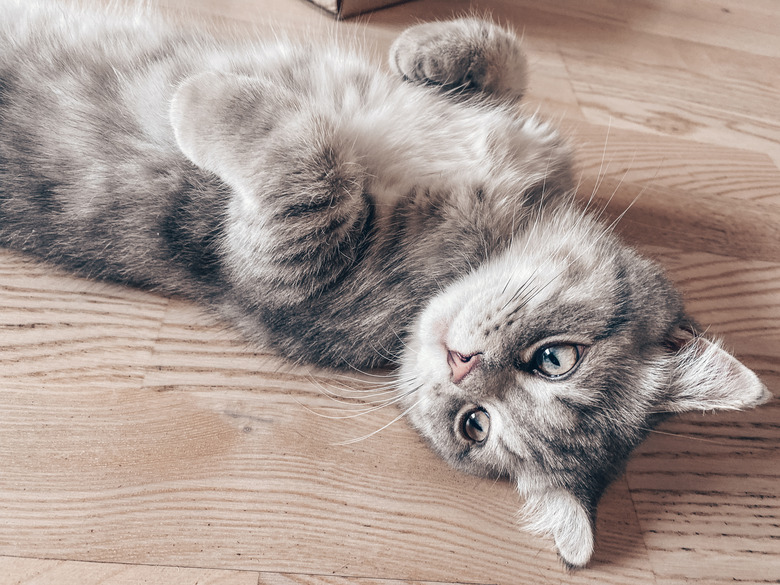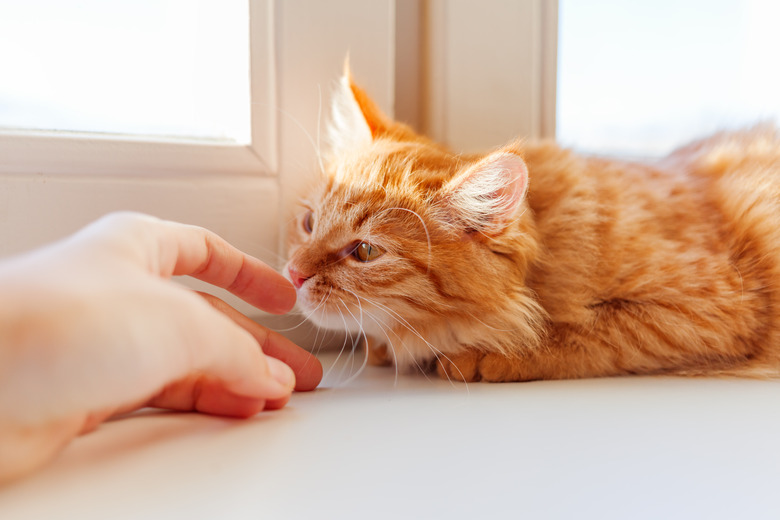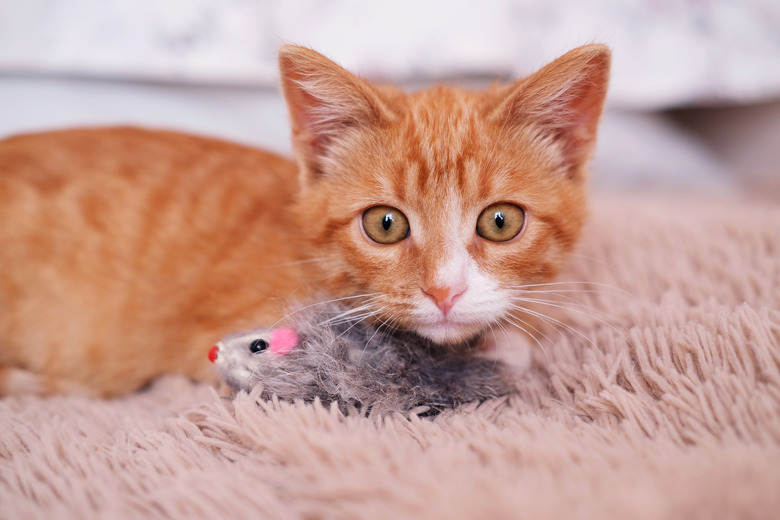How To Ask Visitors To Respect Your Cat's Space
In many ways, cats are just like people. Both species can be moody and playful, suffer from anxiety or allergies, and we even have many of the same requirements for a happy life — including shelter, water, food, and companionship. Also, both cats and humans can react oddly to new people. Sometimes we are friendly and outgoing, but, other times, we are shy and may feel threatened or fearful when someone new enters our space. So if you live with a cat who is aggressive or frightened when visitors come to your door, you can likely address the behavior with a commonsense approach. Because, hey — both you and your cat need to feel safe in your own homes. But unlike your kitty, you have the cognitive ability to understand that your visitor is a friend and not a threat.
It’s ok to ask visitors to respect your cat’s space
It's ok to ask visitors to respect your cat's space
According to the cat trainers with The Cat Behavior Clinic, the best way to ask visitors to respect your cat's space is by simply asking them to ignore your cat when they enter your home. Many people are not pet people, and that's ok. So when a visitor enters your home, it's your job to politely educate them on the best ways to interact with your cat. Remember, many guests may not have experience with felines or animals, in general. They may treat your cat as they would another human by attempting to interact with them — not understanding your kitty's temperament, mood, or body language.
"Cats are not always inviting contact when they approach a stranger. When they come near with either a stiff or, in some cases, flicking tail, they are often exploring, and not inviting contact," notes Dr. Sharon Crowell in Cat Behavior: Social Organization, Communication and Development.
Advocate for both your cat’s needs and your guests’ safety
Advocate for both your cat's needs and your guests' safety
The best way to advocate for your cat's needs is to establish house rules for guest-and-cat communication. For example, the carers at the Battersea Dogs and Cats Home recommend:
- Stay calm and ignore the cat. Let the cat have time to acclimate to the presence of new people in their space. If a cat decides to interact with your visitors, they will do so on their own time.
- Always wait for a cat to approach you. Humans should not attempt first contact with a cat, especially an aggressive one. Similarly, visitors should always wait for a cat to touch them before attempting to touch or stroke the cat.
- Coach guests on how to interact with cats. Encourage them to gently touch the cat around its chin, cheeks, and in between its ears, and to avoid the tail and tummy. Also, teach visitors how to read the signs that your cat is enjoying the interaction.
- There is too much of a good thing. Initially, limit your cat's exposures with guests and gradually increase the amount of interaction time.
Stakes are especially high with children
Stakes are especially high with children
Disaster can strike when visitors do not understand your cat's behavioral queues. Your cat may lash out, swipe, bite, or claw. However, your younger visitors are more vulnerable because of their excitement and inexperience with animals. This is why it's especially important to keep a close eye on children who have entered your cat's space. The CDC reports that over 12,000 Americans each year suffer illnesses caused by cat scratches, and that children aged 5 to 9 years old are disproportionately affected.
To avoid this scenario, it's crucial that you read your cat's body language on behalf of your guests by understanding the signs a cat is irritated. These include:
- Swishing tail
- Crouched stance
- Ducking head into shoulders
- Ears turned back or flat
- Low-pitched vocalizations
How to say hello to a cat
How to say hello to a cat
Yet, when your cat is open to interacting with guests, they'll communicate this by rubbing against a visitor, following them into a room, showing their belly, or blinking their eyes slowly. When this type of invitation happens, teach your guest how to say hello.
First impressions are important with both cats and humans. So put your best foot forward with these tips to greet a cat.
- Avoid prolonged eye contact
- Pay close attention to your body language and consider making yourself smaller by kneeling down
- Never reach down towards a cat
- Instead, lower your hand to ground level and then slowly extend it upwards several inches away from their nose
- Allow the cat to rub against your hand or smell you
- Once introductions have been made, gently stroke the cat
How to help your cat get used to visitors
How to help your cat get used to visitors
Cats are often shy or hesitant with house guests. They are basically always on the alert for potential threats, and your cat won't be able to tell that the person at the door is just your brother-in-law dropping off your sister's birthday cake. Helping your moggie become accustomed to guests is a big part of your job as a cat steward. Here are some tips to help your cat get used to visitors.
- Prepare your space. Create an enriching social environment for your cat by adding furniture, beds, and scratching posts that give your kitty places to climb or hide when they feel insecure. Cat toys, feather toys, laser pointers and other enriching objects provide both distractions and ways for guests to interact with kitties that do not involve touching.
- Use training treats. With high-value treats, you can train your cat to associate sacks with the sounds of the doorbell or door knocking. Ask a friend or neighbor to ring the doorbell and reward your moggie after each chime. Work your way up to giving a treat whenever your assistant walks through the door. Continue this treat training whenever a guest visits.
- Clicker train your cat. Yes, cats can be clicker trained, and it works similarly to treat training. Keep in mind nervous cats may take longer to train, but with a little help and a lot of patience, you can help your cat get used to visitors.
In Summary
In Summary
Not everyone understands how to interact with cats — this includes your family and friends. So it's your job to ask visitors to respect your cat's space when they enter your home. Ask guests to ignore your cat, until the cat approaches them. Then coach your visitors on the best way to interact with your kitty. Also, create an enriching social space for your cat to help them feel comfortable with visitors. It may take some work at first. But having a stress-free and happy cat is well worth the effort.



